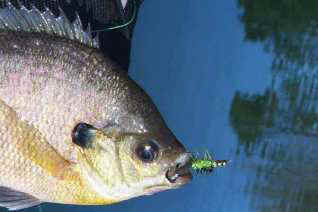|
This article (in slightly different form) appears in the Spring 2000 issue of FLY Tyer magazine. Subscribe today.
The Bead Rattle Fly by Kent Edmonds Wooly Buggers have always been one of my favorite flies. Over the last few years, I've often tied them with bead heads, for the added flash and weight. I've also begun incorporating the new sparkle chenille and bright, synthetic dubbing materials. While tying sparkle bead-head woolies one night, I ran out of large beads. Since I needed the flies for a guided trip the next day, I decided to use two smaller beads on each fly. On a guide trip the next day, the flies worked well, taking bass and bluegill from deeper lies. Our ponds in western Georgia, where I live, are often have a significant algae bloom that restrict underwater visibility and the added flash of the double bead seemed to help. As I finned around in my float tube watching my clients catch fish, I wondered if the double-bead tie could be made to add another attractant-sound. Although the Woolly Bugger is a great design, I figured that the more things you have going for you, particularly in dark water, the better. That night I began working on my first Bead-Rattle Buggers. The basic idea is simple enough. Leaving a little extra space between the fly's body and the hook eye allows the beads to slide back and forth. As you fish the fly, the beads rattle against the shank, against the wire stop at the front of the body, against each other, and against the hook eye. Executing the idea was a little less simple; we'll get to the tying challenges in a minute. My new, noisy flies worked very well. That's hardly surprising, because sound is a proven fish attractant (see the addendum on the Fish's Lateral Line and Sense of Hearing at the bottom of this article). Conventional rattles add sound, but they also add bulk to a fly and complexity to the tying. A physicist friend tells me that, thanks to their greater mass, beads produce lower-frequency sounds than do the tiny balls inside glass or metal rattles, and that these low frequencies carry farther in water.
On larger flies, you can combine a sliding bead with dumbbell or bead-chain eyes. A small bead and a pair of bead-chain eyes add very little weight to a big fly, but they still make enough noise to attract fish. According to my unscientific bathtub tests, lead eyes produce less sound, but my field tests indicate they make enough to get a fish's attention. The possibilities are almost endless. Brass, steel, copper, aluminum, tungsten, glass, and plastic beads come in many sizes. Different combinations of sizes and materials produce different sounds, and beads combined with metal eyes make yet another range of noises. You can experiment with combinations the same way I do: dunk your head in a full bathtub and shake a fly next to your ear. Fish might not care about the difference between, say, a pair of copper beads clicking against each other and a copper bead rattling against a pair of bead-chain eyes, but bathtub tests let you determine such things as how to get the most sound with the least weight. And sometimes fish do seem to find some sounds more appealing than others. Try various combinations in your favorite waters, and listen to what the fish tell you.
Making a double-bead rattle seems easy until you try it for the first time. As you wind materials forward on the hook and tie them off, it's hard to avoid crowding the beads and eventually jamming them against each other and the eye of the hook. When that happens, the fly can't rattle. You can eliminate the problem by fashioning a stop with any of the wires commonly used
to make ribs on flies. Slide the beads onto the hook after flattening the barb. If your
beads have tapered holes, as many fly-tying beads do, install the second (rear) bead with
the small end of the hole facing the bend of the hook. Attach the thread about three and If you have enough patience, you can make the stop with tying thread alone. But wire lets you build up the necessary bulk much more quickly, and a wire stop becomes another hard surface against which a bead can click;
The Woolly Bugger design lends itself nicely to Bead-Rattle construction, and converting your favorite patterns to Bead-Rattle Buggers is a good way to get started with this type of fly. Naturally, the beads at the front of the hook result in a shorter body. If that matters to you, or if you discover that it matters to the fish, use a larger hook; that is, tie a size 6 fly on a size 4 hook. Or you can use a hook with a longer shank; a 4X-long model instead of your usual 3X-long hook, for instance. Bead-Rattle Minnows You can adapt the Clouser Deep Minnow to Bead-Rattle tying. After a suggestion from
Lefty Kreh, I began tying Deep Minnows without underwings; that is, I omit the hair
usually tied on the same side of the shank as the dumbbell eyes, and dress the hook only
on the point side of the shank. It turns out that tying a Deep Minnow that way makes it
easy to add a sliding bead behind the metal eyes. Slide the bead onto the hook with the wider end of the hole facing the hook eye. Attach the thread just forward of the hook point, tie on a piece of wire, and build a stop as described earlier. Make sure that you leave enough room to attach the dumbbell eyes and the wing without crowding the bead; it must be able to slide between the wire stop and the dumbbell. Tie off the thread and superglue the stop. Reattach the thread at the front of the hook. Tie on the dumbbell in front of the bead. Use fewer wraps rather than more; building up a lot of thread bulk around the dumbbell's stem will keep the bead from contacting the metal eyes. A drop of superglue on the wraps will help to secure the dumbbell. After the glue dries, invert the hook and construct the fly's wing, using your favorite combination ~ hair and flash material.
A friend and I made the first trial of Bead-Rattle Minnows in Robin Lake at Callaway Gardens on a rainy, windy day last winter. More than two inches of cold rain had already fallen by the time we began wading the shallows and throwing sinking-tip lines into the waves. In the first hour, I took a dozen bass on a Bead-Rattle Minnow while my friend went fish-less. I gave him one of the flies, and by the end of the afternoon we had released about 75 bass between us. Fishing Bead-Rattle Flies Generally, fishing a Bead-Rattle pattern is much like fishing any streamer
or bucktail. To get the most sound out of the fly, use a jerky retrieve with a lot of
sharp twitches. I have no idea what fish interpret the sound as, but they certainly like
it. Although I originally tied Bead-Rattle flies for stained, still waters, these noisy patterns have proved just as successful in clear water. Perhaps the sound provides the final cue that triggers a strike. For whatever reason, Bead-Rattle Buggers and Minnows have caught fish for me in still and moving water, in turbid ponds and clear trout streams. So far, my rattling patterns have taken trout, largemouth, hybrid, striped and shoal bass, bluegills, and even catfish. No doubt they'll work on other species in fresh and salt water. Add some sliding beads to your favorite flies, and you'll add another dimension to their appeal. Kent Fdmonds is a fly-fishing guide and instructor at Callaway Gardens in Georgia. He also guides on the Flint River, West Point Lake, other local waters, and on the Soque River in north Georgia at Brigadoon Lodge. He maintains a website - Flyfishing West Georgia & Beyond - with regular fishing reports on area waters and other info. The Fish’s Lateral Line and Sense of Hearing Besides sight, smell, and other senses that most vertebrates possess fish have a lateral-line sensory system by which they detect vibrations and changes in water pressure. The lateral line consists of sensitive nerve endings contained in a row of tiny. specialized organs connected to the environment by pores or canals. We cannot imagine what sort of perception or information this uniquely piscine system provides; the Encyclopedia Bnttanica notes that we might think of the lateral line "as a remote sense of touch." In some species and in some environments, a fish's lateral line is probably at least as important as any of its other senses. A bug falling to the water, a crayfish trying to burrow its way under a stone. a fleeing minnow, an angler kicking a rock-each of these sends a distinctive signal that the fish detects through its lateral line. Although they do not have external ears as mammals do, fish also have a good sense of hearing. Water transmits sound very well. and sound waves pass through a fish's head to its hearing organs. A fish can hear your distant footsteps on the bank or the faint sound of a crayfish scurrying over rocks. Its lateral line lets it sense a swimming crayfish or minnow, and also tells it the location and distance of the crawdad or baitfish. Many lures and some flies have been designed to take advantage of a fish's remarkable ability to detect sounds and pressure waves. There's little doubt that some flies work not only because of their appearance, but also (or even primarily) because of the pressure waves they generate. The same may be true of certain retrieves - erratic. stop-and-go retrieves might catch fish not because it makes a fly look like injured bait, but because it makes the fly sound like an ailing baitfish. Kent Edmonds
|
|
|
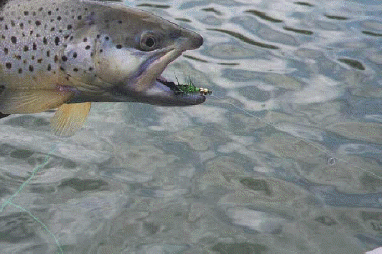
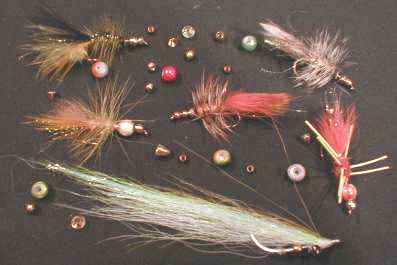
 Building The Rattle
Building The Rattle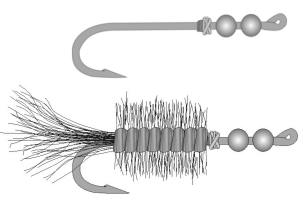 a half bead-diameters behind the eye. Tie in a piece of wire and make three
or four tight wraps with it toward the hook eye. Make sure that the beads have plenty of
room to slide back and forth, and then wrap the wire back over the first wraps. Crisscross
the wire back and forth to build up a stop for the rear bead. Secure the wire, clip the
excess, and carefully apply superglue to the stop. All the rest of your tying is done
behind the wire stop. As you complete the fly, take care to keep the whip-finish and head
cement behind the foremost wraps of wire.
a half bead-diameters behind the eye. Tie in a piece of wire and make three
or four tight wraps with it toward the hook eye. Make sure that the beads have plenty of
room to slide back and forth, and then wrap the wire back over the first wraps. Crisscross
the wire back and forth to build up a stop for the rear bead. Secure the wire, clip the
excess, and carefully apply superglue to the stop. All the rest of your tying is done
behind the wire stop. As you complete the fly, take care to keep the whip-finish and head
cement behind the foremost wraps of wire.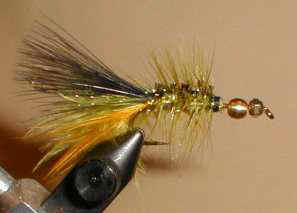

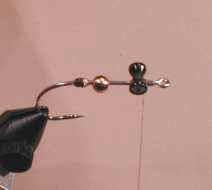
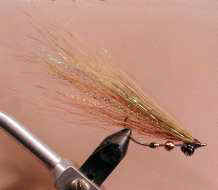 Altering the fly this way does not change the Deep Minnow's silhouette. To
make a white and chartreuse pattern, for example, simply attach sparse clumps of white
hair, Krystal Flash, and chartreuse hair on the point side of the hook in front of the
dumbbell. Putting all the hair on one side of the hook does let you add the rattle effect,
which significantly improves the fly's fish appeal. An extra benefit of this method is
that the sliding bead provides extra weight without increasing the fly's width. The big,
wide dumbbells often used on Deep Minnows tend to hang up or catch weeds on the retrieve.
A Bead-Rattle Minnow 'vith smaller eyes and a sliding bead slides through vegetation. If
you want a lighter bucktail for shallow-water fishing, replace the dumbbell with a pair of
head-chain eyes. The fly will still ride with its point up.
Altering the fly this way does not change the Deep Minnow's silhouette. To
make a white and chartreuse pattern, for example, simply attach sparse clumps of white
hair, Krystal Flash, and chartreuse hair on the point side of the hook in front of the
dumbbell. Putting all the hair on one side of the hook does let you add the rattle effect,
which significantly improves the fly's fish appeal. An extra benefit of this method is
that the sliding bead provides extra weight without increasing the fly's width. The big,
wide dumbbells often used on Deep Minnows tend to hang up or catch weeds on the retrieve.
A Bead-Rattle Minnow 'vith smaller eyes and a sliding bead slides through vegetation. If
you want a lighter bucktail for shallow-water fishing, replace the dumbbell with a pair of
head-chain eyes. The fly will still ride with its point up.